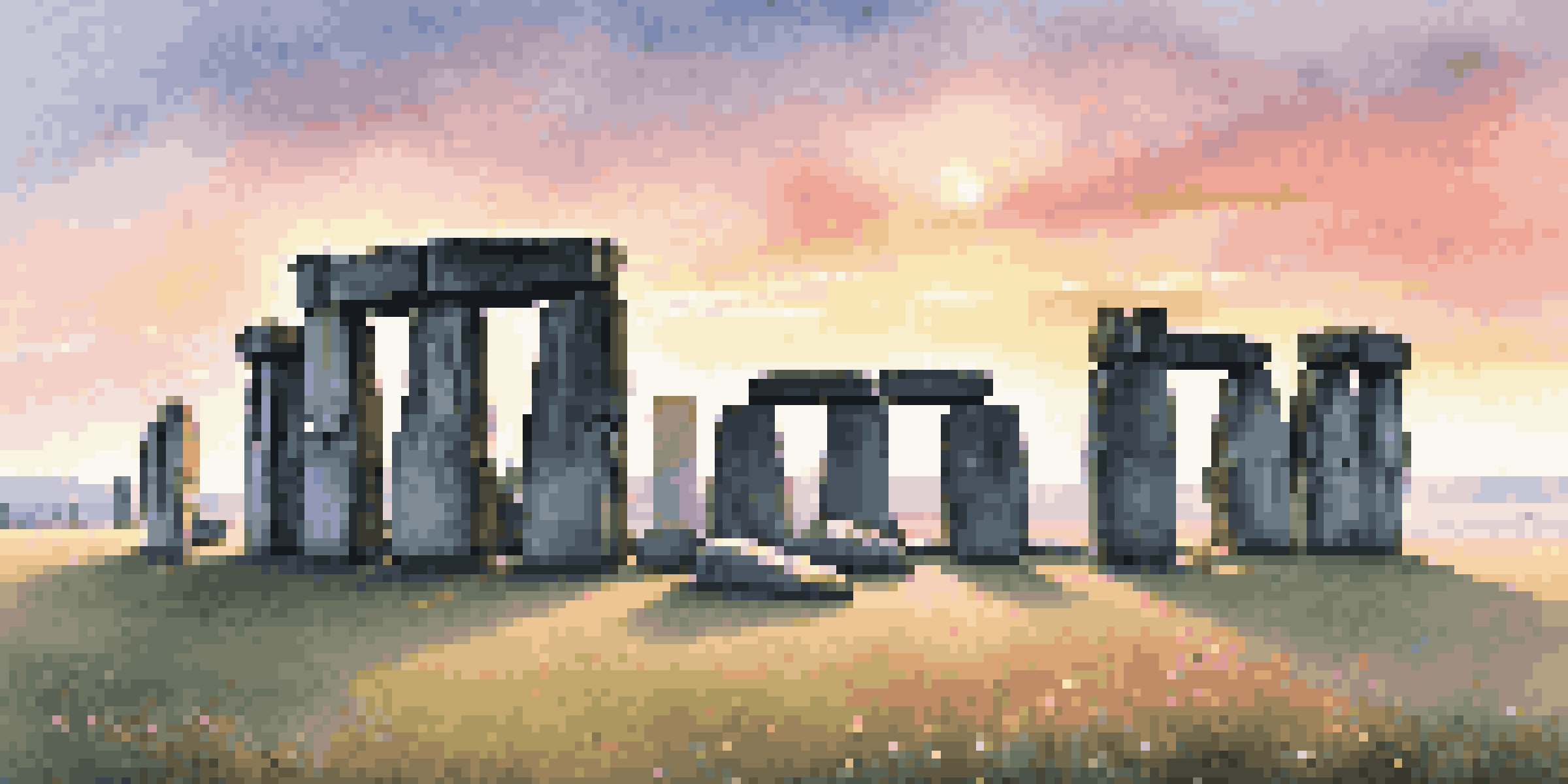Stonehenge: Mysteries of the Ancient World Revealed

The Enigmatic Origins of Stonehenge
Stonehenge, a prehistoric monument located in Wiltshire, England, has captivated historians and archaeologists alike for centuries. Its construction began around 3000 BC, but the true purpose and methods behind its creation remain shrouded in mystery. Some theories suggest it served as a burial ground, while others propose it was an astronomical observatory, aligning with solstices and lunar cycles.
Stonehenge is a monument that embodies the human desire to connect with the cosmos and the cycles of life.
The stones themselves, some weighing up to 25 tons, were sourced from distant locations, which raises questions about the techniques used to transport and erect them. This feat of engineering is particularly remarkable given the limited technology available during that time. The sheer scale of the project indicates a society capable of significant organization and cooperation.
As we delve deeper into the origins of Stonehenge, we realize it reflects the values and beliefs of the people who built it. Whether a place of worship, an astronomical calendar, or a gathering site, Stonehenge embodies the human desire to connect with the cosmos and the cycles of life.
The Stone Circle: A Closer Look
The iconic stone circle of Stonehenge is composed of large sarsen stones arranged in a circular formation, with smaller bluestones positioned within. Each stone's placement appears intentional, suggesting a deeper meaning and purpose. The arrangement may have been designed for ritualistic ceremonies, aligning with celestial events like the summer solstice.

The bluestones, believed to have healing properties, add another layer of intrigue to the monument's significance. Some researchers speculate that these stones were transported from the Preseli Hills in Wales, approximately 200 miles away. This remarkable journey implies that the builders placed great importance on these materials, possibly associating them with spiritual or medicinal qualities.
Mystery of Stonehenge's Purpose
The true purpose of Stonehenge remains elusive, with theories ranging from an astronomical observatory to a healing site.
Understanding the stone circle's layout invites us to ponder the cultural and spiritual beliefs of ancient communities. It illustrates how they harnessed natural elements to create a sacred space, fostering a sense of unity and purpose that resonates even today.
Archaeological Discoveries at Stonehenge
Over the years, numerous archaeological excavations have shed light on the various phases of Stonehenge's construction and use. Tools, pottery, and human remains discovered nearby provide valuable insights into the lives of those who frequented the site. These findings suggest that Stonehenge was not merely a solitary monument but part of a broader landscape dotted with other significant structures.
The past is never dead. It's not even past.
One of the most compelling discoveries was the presence of a nearby henge, known as Durrington Walls, which likely served as a gathering place for rituals and celebrations. This connection between Stonehenge and its surrounding environment emphasizes the importance of community in the ancient world. It also indicates that the site held a greater significance than previously understood.
As archaeologists continue to uncover new evidence, we are constantly revising our understanding of Stonehenge's role in ancient society. Each discovery adds another piece to the puzzle, revealing the complex interplay of rituals, beliefs, and social structures that defined the lives of those who built this remarkable monument.
Theories and Speculations: Why Was It Built?
The purpose of Stonehenge has sparked countless theories, each more fascinating than the last. Some believe it served as an astronomical observatory, with its stones aligning perfectly with the sunrise on the summer solstice and sunset on the winter solstice. This perspective highlights the ancient people's connection to the cosmos and their desire to track the passage of time.
Others suggest that Stonehenge was a site for healing, with the bluestones believed to possess curative properties. This theory resonates with the idea that ancient cultures often revered natural elements for their supposed mystical qualities. This connection to health and wellness may have drawn people to the site for centuries.
Cultural Legacy of Stonehenge
Stonehenge has become a symbol of ancient history and cultural pride, attracting millions and inspiring artists globally.
While no single theory can fully explain Stonehenge's purpose, each adds depth to our understanding of this iconic monument. The ongoing debate reflects our natural curiosity about how ancient people lived, worshipped, and perceived their world.
Cultural Impact and Legacy of Stonehenge
Stonehenge has transcended its origins to become a symbol of ancient history and a source of national pride for England. Millions of visitors flock to the site each year, drawn by its mystery and grandeur. The monument inspires artists, writers, and musicians, who incorporate its imagery and themes into their work, ensuring its legacy endures.
The UNESCO World Heritage designation further solidifies Stonehenge's importance, acknowledging its cultural significance and the need for preservation. Efforts to protect and maintain the site highlight the ongoing commitment to understanding and honoring our historical roots. This dedication reflects a shared responsibility to safeguard cultural heritage for future generations.
As we explore the impact of Stonehenge, we see how it captures the imagination and curiosity of people worldwide. Its continued relevance in contemporary culture serves as a reminder of our intrinsic need to connect with history and the mysteries that shape our existence.
Modern Interpretations and Rituals at Stonehenge
As we move into the modern era, Stonehenge has become a focal point for contemporary rituals and celebrations. Each year, thousands gather to witness the summer solstice, honoring ancient traditions while fostering a sense of community. This blending of past and present illustrates how Stonehenge continues to resonate with people's spiritual and cultural identities.
The rise of neo-paganism has also contributed to a revival of interest in Stonehenge as a sacred site. Many modern practitioners view the monument as a place to connect with ancient wisdom and spirituality. This renewed focus invites us to consider how our understanding of the past can influence and enrich our present lives.
Preservation Challenges Ahead
Despite protections, Stonehenge faces threats from tourism and climate change, highlighting the need for ongoing conservation efforts.
Through these modern interpretations, Stonehenge evolves beyond a mere relic of history, becoming a living monument that inspires connection, reflection, and celebration. It's a beautiful reminder that the past can inform our present, enriching our shared human experience.
Preservation Challenges Facing Stonehenge Today
Despite its status as a protected site, Stonehenge faces numerous preservation challenges. Increased tourism, climate change, and nearby construction pose significant threats to the integrity of the monument. Balancing the need for public access with conservation efforts is a delicate dance that requires ongoing attention and resources.
Local authorities and conservationists are working tirelessly to protect Stonehenge from potential damage. Initiatives include restricting access to certain areas, implementing visitor management strategies, and conducting regular assessments of the site's condition. These efforts underscore the importance of safeguarding our cultural heritage for future generations.

As we confront these preservation challenges, we are reminded of our collective responsibility to protect sites like Stonehenge. By fostering awareness and appreciation for its historical significance, we can ensure that this ancient wonder continues to inspire curiosity and wonder for years to come.